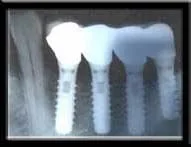- Overview
- Implant Replacement for Single Teeth
- Implant Replacement for Multiple Teeth
- Implant Supported Partial/Full Dentures
- Implant Placement
- Patient Selection
- Risks of Implant Placement
Overview
For almost a hundred years dentistry has tried, with limited success, to find a way to replace missing teeth with artificial teeth that attach to the jawbone. Twenty-five years ago the technique was perfected, and now hundreds of thousands of patients have dental implants placed each year.
Implants are titanium posts that are placed in the bone to serve as the replacement for the root portion of a missing natural tooth. The implant is biocompatible with human tissue, and in three decades of use there have been no known foreign body reactions. After allowing time for the jawbone to bond to the surface of the implant (osseointegration), a post is attached to the implant. This post exits the gum and a crown or other restoration is placed on the post. The final restoration is similar to a crown on a natural tooth, and is not removable. It feels and functions as a normal tooth. This ability to add a tooth where it is needed has changed the way dentistry is practiced.

Missing front tooth to be replaced with an implant

Implant inserted in jawbone, and gum closed over implant

After 4-6 months of healing, access hole made in gum to uncover implant, and a post screwed into the implant

Permanent crown cemented to post
Implants can be used to hold single crowns, or multiple crowns and bridges. However, connecting natural teeth and implants with bridges is generally not advised.
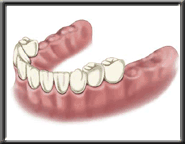
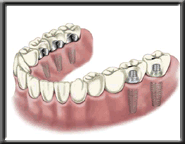
Multiple implants used to replace back teeth
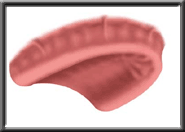

Multiple implants placed in upper jaw with no natural teeth, and restored with non-removable, complete crown and bridge dentistry
In addition to holding crowns, implants can be used to support partial dentures and "overlay" dentures, where the appliance is supported by implants but can be removed.
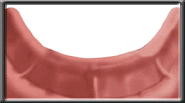
Edentulous lower jaw
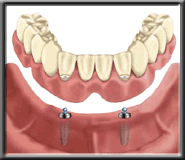
Two implants placed, securing a denture with O-rings
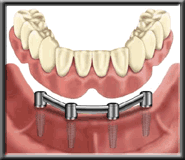
Four implants supporting a bar upon which the denture clips. This is a very secure denture when seated.
There are many benefits to using dental implants. When teeth are lost, ongoing shrinkage of the jawbone occurs, which can cause the face to look older. This shrinkage can also make adequate fit of a partial or full denture difficult. Placing implants can slow or stop this process. Dental implants look, feel, and function like natural teeth, and offer a tremendous improvement in comfort, speech, eating, and convenience over conventional partial and full dentures.
Implant Replacement for Single Teeth
While a single tooth can be replaced with a removable appliance, the looks, function, and convenience of a "permanent" replacement are far superior. In the past, this could only be accomplished with a bridge, where the teeth on either side of the missing tooth are crowned, with the replacement tooth connected to the crowns.
This is an excellent restoration, but many people would prefer not to have to "prepare", or cut down, the adjacent teeth. Today, implants have become so predictable they are often recommended in place of a bridge to replace single missing teeth.
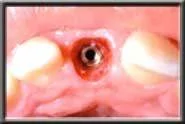
Implant inserted to replace missing front tooth

X-ray of implant with crown cemented

Restoration completed with crown placed

Close-up of beautiful cosmetic result.
It is impossible to tell which tooth
was replaced with the implant/crown.
The advantages of implants over bridges include:
- It is not necessary to drill down the adjacent natural teeth to make crowns.
- The teeth remain separate, making cleaning (flossing) easier.
- If a bridge fails, the entire bridge must be removed. Implants are stand-alone.
- Implants cannot decay, the main reason for bridge failure.
Implant Replacement for Multiple Teeth
Implants can be used to support multiple teeth, or bridges. They are very useful when the natural teeth are not strong enough to support a bridge, or when there are no teeth available to which a bridge can be connected. In these cases, implants offer the only solution for a permanent restoration and an alternative to a removable appliance.
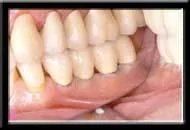
Completed implant supported bridge
Implant Supported Partial and Full Dentures
Conventional full dentures, particularly lower dentures, are often loose, and offer only marginal chewing ability. This may also be true of partial dentures that have only a few teeth supporting them. Implants are the solution, and offer remarkable support for removable appliances. In fact, implants were originally developed primarily to help the millions of people with ill-functioning dentures.

Five lower implants supporting a bar to which the denture clips
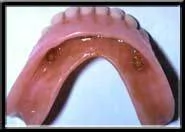
Lower denture

Underside of denture showing clips
The advantages of an implant supported removable appliance include:
- More secure retention and fit of appliance, improving function and comfort
- Less stress on any remaining natural teeth holding the appliance
- Reduction or elimination of bone shrinkage where implants placed
Implant Placement
Implant placement is surprisingly easy, and generally there is little more than "aspirin pain" post-operatively. This is because the bone that receives the implant has no nerve endings, and the only minor discomfort is the small incision in the gum. The implants are checked regularly after placement to follow healing. It takes 3-6 months for the implants to integrate (bond) with the jawbone, at which time the post is placed. The last phase is placement of the final crown or appliance. (See Implant Treatment Outline).
Patient Selection
The ideal candidate for dental implants is in good general and oral health. Smoking, while not a contraindication, is a risk factor. For successful implant placement, there must be sufficient bone height and width to hold the implant. In the lower jaw there must also be sufficient bone available above the mandibular nerve, which runs within the jawbone. The amount of bone available is determined by clinical exam, and by x-rays. If insufficient bone exists, we now have the ability to increase the amount of bone with ridge augmentation procedures. In the upper arch, the proximity of the sinus may reduce the amount of bone available. Sinus lift procedures can add bone to the floor of the sinus, allowing for implant placement. In cases where there are questions about bone anatomy, a CAT scan may be utilized to provide needed details (see Sim/plant).
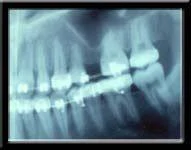
Sinus position too low to allow placement of implant
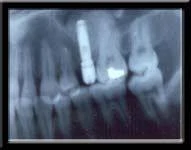
Sinus lift procedure adds bone to sinus floor, allowing implant
Risks of Implant Placement
As with any surgical procedure, there are risks involved with implants. The greatest single concern with implant placement is impingement on the mandibular nerve, which is found in the lower back jaw. Damaging this nerve can cause a permanent numbness of that side of the lower lip. By carefully evaluating the position of the nerve with x-rays or
Sim/plant, the risk of injury is very small and seldom occurs.
Another complication of implant placement is infection, an unusual occurrence that generally develops within six months of placement and may cause failure. We usually do not know why the implant fails, but it is thought it may be due to bacteria that were already present in the bone before the implant was placed. Fortunately, most failed implants can be replaced with another implant, once the site has healed. The success rate of implants reported in the dental literature ranges from 92%-97%, depending on the study. Implants can successfully be placed in adults of any age, although certain health problems may contraindicate their use. Your dentist will determine if you are a candidate for dental implants after a careful review of your dental and medical history.

